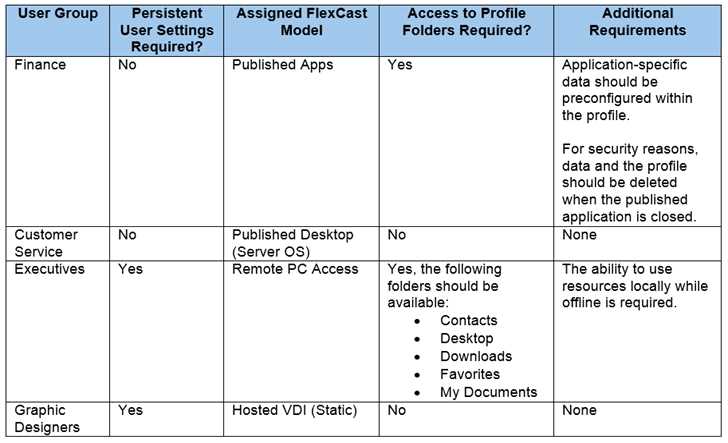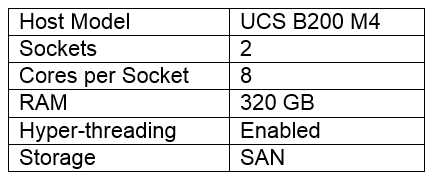Citrix 1y0-403 practice test
Citrix Virtual Apps and Desktops 7 Assessment. Design and Advanced Configurations Exam
Question 1
Scenario: A Citrix Architect is creating a conceptual architecture for a Citrix Virtual Apps and Desktops
environment. Based on some initial discussions around the companys business goals and objectives,
the architect collected the information shown in the exhibit.
Click the Exhibit button to view the information.
Which delivery model should the architect recommend?
- A. Single-Site in Citrix Cloud, with resources hosted in public cloud
- B. Single-Site, single-zone, and single on-premises data center
- C. Multi-Site, and single on-premises data center
- D. Multi-Site in Citrix Cloud, with resources hosted in public cloud
Answer:
B
Question 2
Scenario: A Citrix Architect is designing a new Citrix Virtual Apps and Desktops Service environment
in Citrix Cloud. During the kickoff meeting, management advised that they need a robust, scalable
image-provisioning strategy that allows for easy image and application maintenance to deploy a
large number of applications to users. This should include company-wide applications and
departmental applications to be used only by specific sets of users. Some applications will require
run-once scripts at system startup for product licensing.
Which image provisioning strategy should the architect use for this deployment?
- A. Application Layering
- B. Machine Creation Services (MCS)
- C. Manual Provisioning
- D. Citrix Provisioning (PVS)
Answer:
D
Question 3
Scenario: A Citrix Architect is designing a new Citrix Virtual Apps and Desktops environment. The
architect has identified the Resource Layer requirements shown in the exhibit.
Click the Exhibit button to view the requirements.
Additionally, management identified 2 general Resource Layer requirements:
The time required to configure the solution should be minimized.
Different user groups can use different profile solutions.
Which profile type should the architect consider for the Finance Group?
- A. Hybrid
- B. Mandatory
- C. Roaming
- D. Local
Answer:
B
Question 4
Scenario: A Citrix Architect is implementing a new Citrix Virtual Apps and Desktops environment. The
IT team has purchased 1,000 Citrix Virtual Apps and Desktops Advanced licenses.
The company requires the IT team to produce a report of successful and failed connections of Citrix
Virtual Apps sessions during the last 30 days.
Which two actions does the architect need to take to produce the report? (Choose two.)
- A. Implement Citrix Application Delivery Management
- B. Configure ‘GroomFailuresRetentionDays’
- C. Configure ‘GroomSessionsRetentionDays’
- D. Purchase Citrix Gateway Universal licenses
- E. Purchase Citrix Virtual Desktops Premium licenses
Answer:
BE
Question 5
Scenario: A Citrix Architect is designing a new Citrix Virtual Apps and Desktops environment. While
performing the capabilities assessment for the existing infrastructure, the architect discovered
substantial issues with packet loss and latency, and no current Quality-of-Service (QoS) technology is
in place to manage these issues.
Which capability risk will the architect need to investigate to address these issues?
- A. Access infrastructure
- B. Disaster recovery (DR) plan and implementation
- C. Network architecture
- D. Windows Server and Active Directory (AD) environments
Answer:
C
Question 6
Scenario: A Citrix Architect is designing a new Citrix Virtual Apps and Desktops environment.
Currently, the environment is configured as 2 locations with identical Citrix Virtual Desktops Sites.
Each Site has 2 Delivery Controllers, 2 StoreFront servers, and 1 Citrix ADC high-availability pair. The
same applications have been published from both Sites for all users. Two zones (Zone A and Zone B)
are configured in each Site with 1 Delivery Controller in each zone. The Microsoft Exchange server is
only accessible from Virtual Delivery Agent (VDA) machines in Zone A in each Site.
Six access requirements have been identified:
Users should have a single URL when accessing resources from different Sites.
Users should always connect to the data center closest to their location.
Applications added to Favorites within the Citrix Workspace app should be retained when accessed
from different Sites.
Launched applications and desktops should always connect through a local Citrix ADC.
No duplication of applications published from different Sites.
Microsoft Outlook should always launch in Zone A.
What should the architect recommend configuring to avoid duplication of the same applications
being delivered from different Sites?
- A. ‘Keywords: Featured’ in the properties of the published applications
- B. An Application Group
- C. Zone preferences for VDA machines hosting the applications
- D. Aggregate resources
Answer:
D
Question 7
Scenario: A Citrix Architect is assessing an existing infrastructure for a company that has storage
challenges as a result of hyper-growth. They currently have a large IT infrastructure that consists of
15 hypervisor hosts and more than 200 virtual machines (VMs) worldwide. Management has advised
the architect that they need to improve their storage infrastructure to include high performance and
scalability.
Which storage solution should the architect implement within this infrastructure?
- A. DAS
- B. SAN
- C. NAS
- D. Local
Answer:
B
Question 8
Scenario: A Citrix Architect is designing a new 2,000-user Citrix Virtual Apps and Desktops
environment. The environment will use Windows Server 2016 for all Site infrastructure components
(Delivery Controllers, StoreFront servers, and Citrix Director). Machine Creation Services (MCS) will
be used to provision Virtual Delivery Agent (VDA) machines. The environment will include 2 primary
use cases:
Windows Server 2016 VDA machines providing hosted applications
Windows 10 VDA machines providing random, non-persistent VDI
The IT team has NOT yet purchased the hardware that will be used for the environment, and will
build the Hardware Layer components based on the architects recommendations.
How should the architect design the Citrix Hypervisor resource pools based on Citrix leading
practices?
- A. Windows Server 2016 VDA machines should be placed in 1 resource pool, Windows 10 machines should be placed in a second resource pool, and the infrastructure servers should be placed in a third resource pool.
- B. Windows Server 2016 machines should be placed in 1 resource pool, and all Windows 10 machines should be placed in a second resource pool.
- C. The infrastructure servers and all VDA machines should be located in 1 resource pool.
- D. The infrastructure servers should be placed in 1 resource pool, and the VDA machines should be placed in a second resource pool.
Answer:
D
Question 9
Which access component will support anonymous access within a new environment?
- A. Citrix StoreFront
- B. Citrix Gateway Service
- C. Citrix ADC
- D. Citrix Workspace
Answer:
A
Reference:
https://docs.citrix.com/en-us/xenapp-and-xendesktop/7-6-long-term-service-release/xad-build-new-enviroment/xad-dg-create/xad-dg-manage-users.html
Question 10
Scenario: A Citrix Architect is designing a new Citrix Virtual Apps and Desktops environment. The
design will require three different StoreFront stores and three corresponding Citrix Workspace app
for Web sites. Each different store and Citrix Workspace app for Web site will serve different business
units. Each of these will also require its own branding and SSL certificate. The solution should remain
supported by Citrix.
The architect has already installed StoreFront on a server.
How can the architect achieve the desired design while keeping cost and maintenance requirements
to a minimum?
- A. Create two extra Internet Information Services (IIS) sites, bind the certificates in IIS Manager, copy the StoreFront configurations to the two new IIS sites, and use a text editor to configure all three StoreFront stores.
- B. Deploy two extra virtual servers, bind the certificates in Internet Information Services (IIS) Manager, and install StoreFront on each new virtual server.
- C. Create two extra Internet Information Services (IIS) sites, bind the certificates in IIS Manager, use PowerShell to deploy additional stores to the two new IIS sites, and use a text editor to configure all three StoreFront stores.
- D. Create two extra Internet Information Services (IIS) sites, bind the certificates in IIS Manager, copy the StoreFront configuration to the two new IIS sites, and use the StoreFront console to configure all three StoreFront stores.
Answer:
B
Question 11
Scenario: The IT team of a company needs to mitigate the Hardware Layer to Microsoft Azure. The
Virtual Delivery Agent (VDA) machines are manually provisioned within Microsoft Azure. The IT team
asks a Citrix Architect for a solution for high availability of existing VDA machines in a single Azure
data center. The objective is to be proactive about any hardware failure at Microsoft Azure, so that all
virtual machines (VMs) will NOT be affected.
What should the architect recommend the IT team create in Microsoft Azure?
- A. Resource group
- B. Availability sets with fault domain
- C. Availability sets with update domain
- D. Availability zones
Answer:
D
Reference:
https://docs.microsoft.com/en-us/azure/virtual-machines/manage-availability
Question 12
Scenario: A Citrix Architect is designing a new Citrix Virtual Apps and Desktops environment. During
the project kickoff meeting, the organization stated the following business priorities:
Overall, we want a robust solution that ensures users ability to access resources at any time, even if
the primary data center experiences an outage. Since employees will need to access resources from
both inside and outside the corporate network, we need to ensure that this is enabled in a secure
manner to protect sensitive data."
Which four design decisions align with the organizations stated business priorities? (Choose four.)
- A. Redundancy should be implemented for all infrastructure components
- B. Optimal Gateway Routing must be configured on StoreFront
- C. A multi-Site architecture and disaster recovery (DR) plan is required
- D. Server OS Virtual Delivery Agent (VDA) machines should be used to increase user density per machine
- E. Single-image management should be included in the design
- F. SmartAccess or SmartControl features should be considered for this environment
- G. Citrix ADC is required for this environment
Answer:
ACFG
Question 13
Scenario: An additional zone was recently added to a Citrix Virtual Apps and Desktops environment.
The main zone is located in New York City, and a small, second zone is located in Tokyo. Within the
next year, the number of users in Tokyo is expected to equal that in New York City.
A Citrix Architect recommended the addition of 2 StoreFront servers in Tokyo to support the users.
What should the architect recommend for this environment to ensure user-experience consistency
and reduce WAN bandwidth consumption?
- A. Add 2 StoreFront servers to separate server groups and configure subscription synchronization
- B. Add 2 StoreFront servers and configure the Optimal Gateway routing feature
- C. Add 2 standalone StoreFront servers
- D. Add 2 StoreFront servers to the same server group
Answer:
B
Reference:
https://www.citrix.com/content/dam/citrix/en_us/documents/white-paper/ns-optimal-
gateway
- routing-tech-wp.pdf
Question 14
Scenario: A Citrix Architect is designing a new Citrix Virtual Apps and Desktops environment. The
environment will utilize Citrix Provisioning (PVS) for image management of physical and virtual
machines (VMs). Upon review of the current network infrastructure, the architect determined a
number of considerations that will impact the overall imaging process.
Click the Exhibit button to view the existing internal network and PVS infrastructure details.
What should the architect do to optimize the Citrix Provisioning server to target device
communication and the streaming process?
- A. Enable Replication and set to Fixed
- B. Enable Subnet Affinity and set to Fixed
- C. Enable Subnet Affinity and set to None
- D. Enable Replication and set to Best Effort
Answer:
B
Question 15
Scenario: IT management has decided which server hardware model to use for its new Citrix Virtual
Apps and Desktops Sites, but needs guidance on sizing the Hardware Layer.
Click the Exhibit button to view the host details.
A Citrix Architect is planning to install Citrix Hypervisor 7.x on this host. How many vCPUs will be
available to the Citrix Hypervisor host?
- A. 48
- B. 32
- C. 16
- D. 24
Answer:
C
Reference:
https://www.citrix.com/blogs/2014/03/11/citrix-xenserver-setting-more-than-one-vcpu-
per-vm-to
-
improve-application-performance-and-server-consolidation-e-g-for-cad3-d-graphical-
applications/